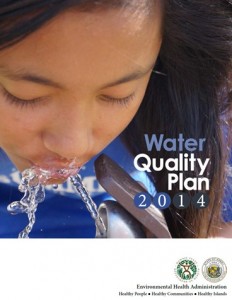Ensuring Clean Drinking Water

D
OH will continue to ensure a continuous supply of clean drinking water and strive to protect our aquifers from any contaminants.
Ground Water Quality
Source Water Assessment and Protection (SWAP) Program
Goals:
- Assess the susceptibility of public drinking water sources to contamination;
- Protect public drinking water sources from contamination; and
- Use source water assessment information to meet drinking water requirements.
Proposed Actions:
- Assess all existing and proposed drinking water sources;
- Create state and local source water protection workgroups; and
- Redevelop and implement the Wellhead Protection Financial Assistance Program.
Comprehensive State Groundwater Protection Program
Goals:
- Establish a mechanism for better understanding of relationships between ground water quantity and quality concerns;
- Demonstrate the State’s proactive approach to ground water protection, justifying increased funding for program development & additional flexibility from the EPA and other federal agencies; and
- Improve public understanding of ground water protection concerns within the State, and provide a broader context for public participation.
Proposed Actions:
- Establish specific ground water protection goals to guide the relevant federal, state, and local programs operating within the State; and
- Establish priorities to guide relevant federal, state, and local programs and activities.
Goals:
- Reduce the number of unpermitted UIC well facilities; and
- Assure proper abandonment of UIC wells.
Proposed Action:
- Improve the UIC database system; and
- Continue to utilize and improve the Environmental Health Administration online e-Permitting System
Upgrading and Eliminating Cesspools
Goal: Eliminate cesspool pollution.
Current Actions:
- Update HAR, Chapter 11-62 to prohibit the construction of new cesspools; and
- Implement the temporary income tax credit for the cost of upgrading or converting a qualified cesspool (HB1140 HD1 SD2 CD1 was signed into law on June 12, 2015, as Act 120 affecting Hawaii Revised Statutes, Chapter 235).
Surface Water Quality
Goal: Develop scientifically-based WQS that: (a) Meet federal requirements; (b) Specify the uses to be protected in State waters; and (c) Provide appropriate criteria and methods for evaluating the attainment of these protected uses.
Current Action: The Clean Water Act requires the State to review WQS every 3 years. The revisions to Hawaii Administrative Rules, Chapter 11-54 became effective on November 15, 2014. Implementation has already begun.
Goals:
- Monitor surface waters of the State;
- Develop and implement monitoring tools and methodologies;
- Protect Hawaii’s aquatic and marine resources; and
- Protect Hawaii’s water recreational community.
Proposed Actions:
- Partnership with USGS to conduct surveys of endocrine active compounds in smallmouth bass to determine existence of chemical contaminants (herbicides, pharmaceutical, and biogenic hormones).
- Partnership with USGS to deploy five Semipermeable Membrane Devices in West Maui to determine existence of pollutant sources and levels in different locations.
Goals:
- Prevent environmental degradation due to nonpoint source pollution;
- Increase the amount of resources devoted to the control of polluted runoff and focus on collaborative efforts to utilize limited resources; and
- Provide outreach and education to the community in partnership with other agencies.
Actions:
- Increase the amount of funding devoted to the control of polluted runoff through best management practices;
- Obtain federal approval of Coastal Zone Nonpoint Pollution Control Program; and
- Issue Request for Proposals for the Watershed Implementation Projects on an annual basis.
Goals:
- Quantitatively assess watershed-scale water quality problems, contributing sources, and pollutant load reductions;
- Provide an analytical basis for implementing pollution controls; and
- Provide assistance with identifying restoration projects to improve water quality and protect public and environmental health.
Proposed Actions:
- Incorporate CWB program elements (beach and surface water monitoring, polluted runoff control, NPDES permits, etc.) into the TMDL process; and
- Collaborate with the counties and other state agencies to prioritize watersheds for restoration efforts and support stakeholder stewardship of watershed resources.
National Pollutant Discharge Elimination System (NPDES) Program
Goal: Regulate point source discharges through permitting and enforcement.
Proposed Actions:
- CWB is planning to implement a statewide MS4* and stormwater system initiative to encourage counties without MS4 permits to implement stormwater controls; and
- CWB will provide financial and technical assistance to implement best management practices (BMPs) and monitoring.
Revising Recycled Water Guidelines
Goal: Increase water reuse statewide.
Proposed Action: Complete revisions to the Guidelines by December 31, 2015.
Drinking Water State Revolving Fund
Goal: Continue to provide low-interest loans
Proposed Actions:
- 2015: Finalize 8 loan agreements worth more than $48 million
- 2016: Finalize 11 loan agreements worth more than $69 million.
Clean Water State Revolving Fund
Goal: Continue to provide low-interest loans
Proposed Actions:
- 2015: Finalize 7 loan agreements worth more than $50 million
- 2016: Finalize 10 loan agreements worth more than $54 million.
The Hawaii Water Plan
The Hawaii Water Plan, Chapter 174C, HRS is described on the State of Hawaii, Department of Land and Natural Resources, Commission on Water Resource Management website.
Protection Policies:
Water Resource Protection Plan (DLNR) & DOH Water Quality Plan
State Needs: State Water Projects Plan (DLNR) & Agricultural Water Use and Development Plan
County Needs: the four County Water Use and Development Plans
In 2016, the DOH will finalize the State Water Quality Plan.
An update on the State Water Quality Plan was recently provided at the 3rd Annual Joint Government Water Conference. A DOH presentation on the updated plan is available online for the public.
DOH will continue to ensure a continuous supply of clean drinking water and strive to protect our aquifers from any contaminants. Towards this overarching goal, the DOH has prepared a Draft Water Quality Plan. The draft plan is available.
From 2016-2019, DOH will implement the actions detailed in the State Water Quality Plan to ensure clean drinking water.
Environmental Planning Office
919 Ala Moana Blvd., Room 312
Honolulu, HI 96814
Phone: (808) 586-4337
Last update: 08/18/2015